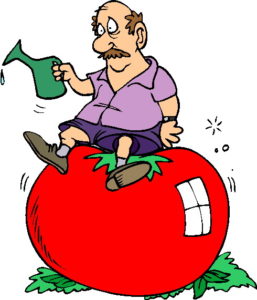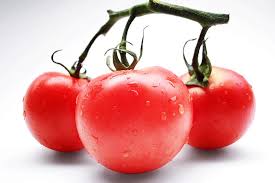Save That Flavor & Aroma!
Tomatoes, tomatoes, tomatoes. Whether a tomato is sun-ripened in the garden and picked red and fully ripe OR picked for storage just as it is turning red (breaking) OR picked fully mature but still green, the question is — What is the best way to store that tomato for maximum flavor?
Fortunately for us, the U.S. Dept. of Agriculture’s research scientists in Fort Pierce, Florida, have been wondering the same thing. The good news is — they have found answers.
What have they been up to?
How to Store a Red, Fully Ripe Tomato
Not all red fully ripe tomatoes are equal. If you are lucky enough to find ripe ready-to-eat tomatoes at your local supermarket or produce stand they probably won’t equal the taste of sun-ripened tomatoes picked right from the garden.
Why not?
Commercially sold tomatoes are usually chilled first before being shipped and then ripened to red. Could it be the chilling that causes them to taste bland (in spite of their good looks) when compared to the just-picked garden variety? And if so, what about the common practice at home of putting ripe tomatoes in the refrigerator for storage? Are we doing this at the expense of flavor? The Agricultural Research Scientists (ARS) decided to find out. In addition, there was one more common practice in the home they decided to investigate: putting ripe tomatoes in hot water to make them easier to peel (called “blanching”). Does this common practice have any effect on flavor?
Testing Procedure
The ARS team divided 60 standard tomatoes into 3 groups:
- One group was refrigerated at 41°F for 4 days.
- A second group was stored at room temperature (68°F) for 4 days and then dipped in 122ºF water for 5 minutes to simulate blanching.
- A control group was stored at 68°F (room temperature) for 4 days.
The team used gas chromatography and an “electric nose” to measure the 45 volatile compounds associated with the release of tomato aroma.
Results
Refrigeration: The results showed that refrigeration greatly reduced aroma and flavor. In the group of tomatoes that were refrigerated, 25 of the 42 aroma compounds were greatly reduced, and the volatile levels associated with flavor were reduced by 68% overall. Jinhe Bai, an Agricultural Research Scientist for the USDA explained that chilling will slow ripening, but like many other tropical and subtropical crops, tomatoes are sensitive to low temperatures. In some fruits (such as tomatoes), chilling is known to cause internal “chilling injuries.” (Yes, the tomato is a fruit.)
The results spell out why it is better NOT to refrigerate RIPE tomatoes. Not only will the flavor be better if tomatoes are not refrigerated, but refrigeration does not substantially extend the ”life” of the tomato.
Blanching: But what about heating, or blanching, tomatoes to make them easier to peel. Does heating affect flavor? It does, and not in a good way. Previous research has shown that once tomatoes have ripened, heating or chilling them can suppress flavor volatiles beyond repair.
How to Store Green & “Breaking” Tomatoes
As summer fades and autumn approaches, the season of the tomato is not quite over. Green tomatoes and “breaking tomatoes” ( those just breaking into red) still weigh down the increasingly spindly vines. Those tomatoes will not now receive enough hours of sunlight to fully ripen on the vine. Yet they can ripen in storage with little loss 0f flavor. In any case they will be much tastier than the bland pre-refrigerated specimens sold at the grocery store.
Harvesting Your Green and “Breaking” Tomatoes
Pick your green and breaking tomatoes BEFORE the first frost. Wash them in cool water to wash away any dirt, bacteria, and fungus. Dry them thoroughly. Throw away any damaged or soft tomatoes or those with spots.
Spread them out about 2-3 inches apart on a tabletop or in a flat, wide container. Put several layers of newspaper or paper towels underneath to absorb liquid from any tomatoes that rot. (That liquid will cause other tomatoes to rot.)
Keep the ripening tomatoes in a warm room (about 65°-75°F) away from direct sunlight. If you want the tomates to ripen more slowly, store them in at 50°-65°F. If you want them to ripen more quickly, try placing a banana or apples near the tomatoes. The fruit gives off etylene gas that helps speed ripening.
Check the tomatoes at least once week. Remove any that are 50% or more red and let them complete warming on your kitchen counter. Throw away any that show signs of rot. Tomatoes ripen slowly – for up to 3 months!
Don’t Refrigerate . . . Unless . . . !
Commercially grown tomatoes sold in the grocery store taste and smell bland because they have been refrigerated before they are ripened to red. However, there is a way to treat tomatoes so they will not lose flavor after they are refrigerated . This method was discovered by Jinhe Bai and his colleagues at USDA’s Agricultural Research Service at Fort Pierce, FL. They harvested 120 standard “Florida 47” mature green tomatoes and divided them into 4 groups for testing 4 different treatments before ripening them at 68°F like commercially grown tomatoes.
One group was briefly heated (placed in 125°F water for 5 minutes). One group was chilled to the industry standard of 41°F. A third group was heated and then chilled; and the control group was simply stored at room temperature, 68°F.
After the tomatoes ripened at 68°F, samples of each group were cut and placed in sealed containers. The containers were opened less than a hour later, and the tomatoes were rated for flavor by 21 volunteers based on the aromas released. The study was designed to evaluate fruit aroma, so only the odors were assessed to eliminate bias from taste and “mouth feel.” Gas chromatography-mass spectrometry us then used to identify levels of 12 key volatile aroma compounds known to give tomatoes their flavor.
What were the results? The results showed that heating mature green tomatoes before refrigerating and then ripening them greatly improves both their flavor and aroma. According to Bai, heating in warm water increases the tomatoes resistance to the internal chilling injury that causes the loss of the tomatoes’ aromatic compounds,
Unfortunately, this heating/then chilling method only saves the flavor of green or breaking tomatoes. It doesn’t work with ripe tomatoes. Chilling will lessen the flavor of ripe tomatoes, regardless.
To sum up . . .
Ripe Tomatoes: Store your sun-ripened tomatoes at room temperature and wash before eating. Do NOT heat or refrigerate first or you will lose some aroma and flavor.
Green and “Breaking” Tomatoes: Pick mature tomatoes BEFORE the first frost. Store them indoors away from direct sunlight and 2-3 inches apart on top of newspaper or other absorbent material. Check them at least once a week and remove any that have started to rot. Keep them at a temperature of 65°-75°F (or 50-65°F if you want them to ripen more slowly). Tomatoes ripen slowly – between 3 weeks to 3 months.
Follow these directions and you will be enjoying your own flavor-rich ripe tomatoes even into February!
P.S. Remember to record your tomatoes’ care and progress in your GARDEN JOURNAL and PLANNER. (You can post photos of your tomatoes, too, in the “Sketch Book & Photo Album” Section of the PLANNER.)
GARDEN JOURNAL and PLANNER by Michelle Marsh
Amazon.com: amzn.to/2r7zwAb
AmazonUK.com: amzn.to/2LnllyA
